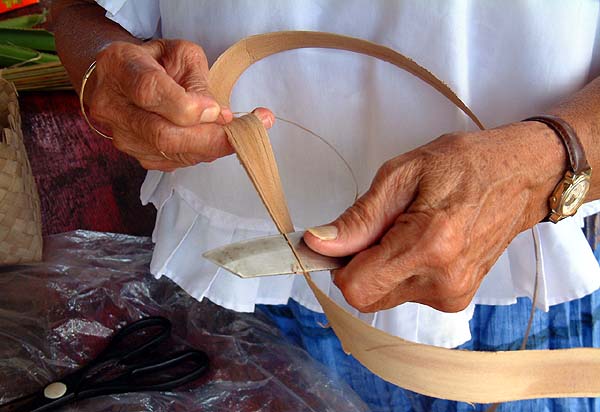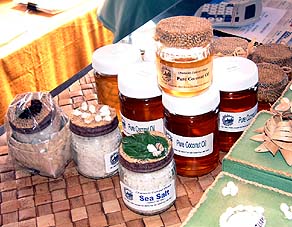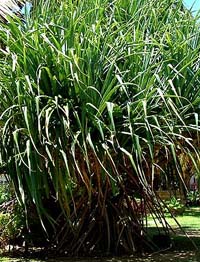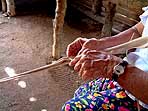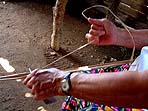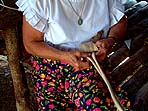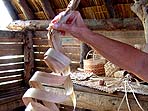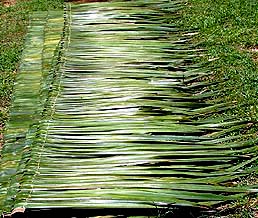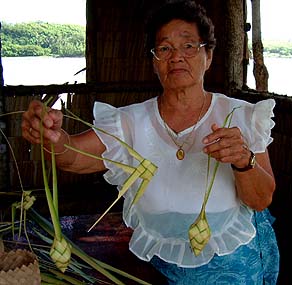 |
 |
 |
 |
||||
|
|
|
|
|
|
|
|
|
|
|
|||||||
|
|
|
|
Tan Floren demonstrates preparation of pandanus leaf.
|
|
|
"The weaving has changed over the years," Judy says. "The coconut leaf plaiting or weaving, that’s probably most traceable back to pre-historic times.The first explorers talked about how fine the weaving was, how beautifully built the houses were, and talked about ancestral worship."
|
||
|
|
||
|
|
"I learned when I was small, you know," Tan Floren tells. This at school too, some of them were teaching us. But I just kept doing it a little at a time, and now I’m starting in here at Gef Pa’go. "My mom would weave the mat, where the family slept. We only had in those days one bedroom, that is when one of the family gets sick, they stayed in that one bedroom. Mostly we slept in the living room. Sometimes we used about three mats, the big one. Comfortable! "For a pillow, we had the real cotton—there’s a tree on the hill, a cotton tree, that’s the only one I saw. So my mom would pick that, and we made pillows out of it. We survived, whatever we had."
|
|
"Before, we were selling and making a lot of money. We sold to representatives from the other side of the island, so that they could then sell it. We even made coconut oil and sold it by the gallon, so we made extra money. My sister and I would go to our place, and we’d husk then carry in our bag, 20 each coconuts, and come home, we’d grate it and start cooking it to make coconut oil. And that’s where we made our extra money." "I pull the leaves off the pandanus tree, and I take out the thorns, and then I roll it. I have to take out the thorns, because otherwise it is going to hurt me. The thorn in here is hard, you have to take it out and then roll it, and put it in the sun. It’s hard to make, it takes me time to do it."
|
|
|
|
"Once I’ve done that, it’s more easy. But that’s the way the old timers did it. For two days I roll it, and then, I take it out and it stays open. It stays open, and the sun gets to it, and it gets whiter. See how nice it is? It stays open. "I could pull the green leaf off and boil it. The boiled one looks different. I pull about maybe six or eight, I roll it and I boil the water and I put it in for five minutes, all rolled up. Then I put it out in the sun. The longer in the sun, the whiter it gets. I just choose what kind I can make something from."
|
|
|
|
|
Four stages of preparing the pandanus for weaving (click on images to see larger versions): --Preparing to remove the thorny edge of the leaf using a si'i knife; --Removing the thorns in one strip; --Rolling the leaf for drying; --Unfurling the dried roll of leaf, now ready for use.
|
||
|
|
||
|
"I used to make things out of the coconut leaf, but now I’m into pandanus. Nipa palm is just for the thatching and we make brooms out of it. Same as the coconut leaf, only stronger. Nipa lasts longer though, but it is hard to find. Only the coconut leaf is plentiful, so this is what we use mostly. It’s faster. So we weave it, and this is for our thatch roof. It’s not nipa, it’s a coconut leaf, something like this." Tan Floren says that the nipa palm, once plentiful, is now over-harvested to make temporary huts for fiestas, Chamorro Week activities, and other events. Nipa grows in the streams of Inarajan. Click here to see what it looks like.
|
|
|
|
"This is the katupat now, come to be, this is made from the part located in the center part of the coconut tree. So I make the katupat, this is used for cooking the rice, this is the rice bag. You fill half of it, then boil it, how long depends on how large the katupat. A big one, that means more time, this one maybe about 45 minutes, about half an hour to 45 minutes. A smaller one, this one, maybe half an hour. And you have to put salt, to make it taste good—salt in the boiling water, then put it for half an hour this size, and then this one is maybe 45 minutes."
|
|
|
|
|
|
|
"So with this material, I weave
baskets, lunch bags—this is a big one, and this is the small one,
and this is the basket. This is the luncheon set, this is a mat for
plates. I have to make a bigger one for the center part, and then with
these, six, seven set, one big one and three in here. "It’s a lot of work, but I enjoy doing it."
|
||
|
|
||
|
The crafts and skills of the old days are being perpetuated at Gef Pa'go village in Inarajan, and we will learn more about their establishment later. Meanwhile, many important non-material Chamorro values underly today's culture. One good example is the traditions concerning weddings.
|
||
|
|
||
|
|
|
|
|
|

|
| Inarajan Home | Map Library | Site Map | Pacific Worlds Home |
|
|
|
|
|
|
|
|||
| Copyright 2003 Pacific Worlds & Associates • Usage Policy • Webmaster |
|||
